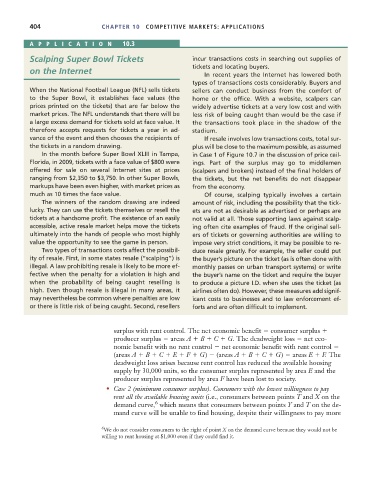Page 430 - Microeconomics, Fourth Edition
P. 430
c10competitive markets applications.qxd 7/15/10 4:58 PM Page 404
404 CHAPTER 10 COMPETITIVE MARKETS: APPLICATIONS
APPLICA TION 10.3
Scalping Super Bowl Tickets incur transactions costs in searching out supplies of
tickets and locating buyers.
on the Internet
In recent years the Internet has lowered both
types of transactions costs considerably. Buyers and
When the National Football League (NFL) sells tickets sellers can conduct business from the comfort of
to the Super Bowl, it establishes face values (the home or the office. With a website, scalpers can
prices printed on the tickets) that are far below the widely advertise tickets at a very low cost and with
market prices. The NFL understands that there will be less risk of being caught than would be the case if
a large excess demand for tickets sold at face value. It the transactions took place in the shadow of the
therefore accepts requests for tickets a year in ad- stadium.
vance of the event and then chooses the recipients of If resale involves low transactions costs, total sur-
the tickets in a random drawing. plus will be close to the maximum possible, as assumed
In the month before Super Bowl XLIII in Tampa, in Case 1 of Figure 10.7 in the discussion of price ceil-
Florida, in 2009, tickets with a face value of $800 were ings. Part of the surplus may go to middlemen
offered for sale on several Internet sites at prices (scalpers and brokers) instead of the final holders of
ranging from $2,350 to $3,750. In other Super Bowls, the tickets, but the net benefits do not disappear
markups have been even higher, with market prices as from the economy.
much as 10 times the face value. Of course, scalping typically involves a certain
The winners of the random drawing are indeed amount of risk, including the possibility that the tick-
lucky. They can use the tickets themselves or resell the ets are not as desirable as advertised or perhaps are
tickets at a handsome profit. The existence of an easily not valid at all. Those supporting laws against scalp-
accessible, active resale market helps move the tickets ing often cite examples of fraud. If the original sell-
ultimately into the hands of people who most highly ers of tickets or governing authorities are willing to
value the opportunity to see the game in person. impose very strict conditions, it may be possible to re-
Two types of transactions costs affect the possibil- duce resale greatly. For example, the seller could put
ity of resale. First, in some states resale (“scalping”) is the buyer’s picture on the ticket (as is often done with
illegal. A law prohibiting resale is likely to be more ef- monthly passes on urban transport systems) or write
fective when the penalty for a violation is high and the buyer’s name on the ticket and require the buyer
when the probability of being caught reselling is to produce a picture I.D. when she uses the ticket (as
high. Even though resale is illegal in many areas, it airlines often do). However, these measures add signif-
may nevertheless be common where penalties are low icant costs to businesses and to law enforcement ef-
or there is little risk of being caught. Second, resellers forts and are often difficult to implement.
surplus with rent control. The net economic benefit consumer surplus
producer surplus areas A B C G. The deadweight loss net eco-
nomic benefit with no rent control net economic benefit with rent control
(areas A B C E F G) (areas A B C G) areas E F. The
deadweight loss arises because rent control has reduced the available housing
supply by 30,000 units, so the consumer surplus represented by area E and the
producer surplus represented by area F have been lost to society.
• Case 2 (minimum consumer surplus). Consumers with the lowest willingness to pay
rent all the available housing units (i.e., consumers between points T and X on the
6
demand curve, which means that consumers between points Y and T on the de-
mand curve will be unable to find housing, despite their willingness to pay more
6 We do not consider consumers to the right of point X on the demand curve because they would not be
willing to rent housing at $1,000 even if they could find it.

